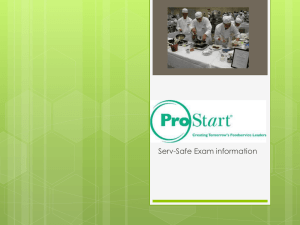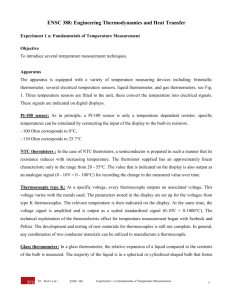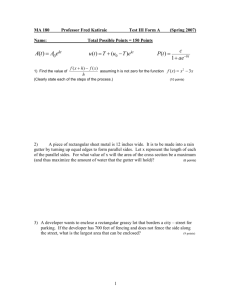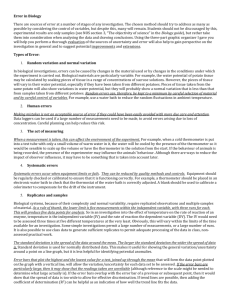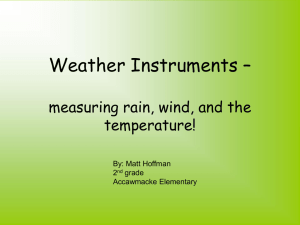Science lesson plan
advertisement
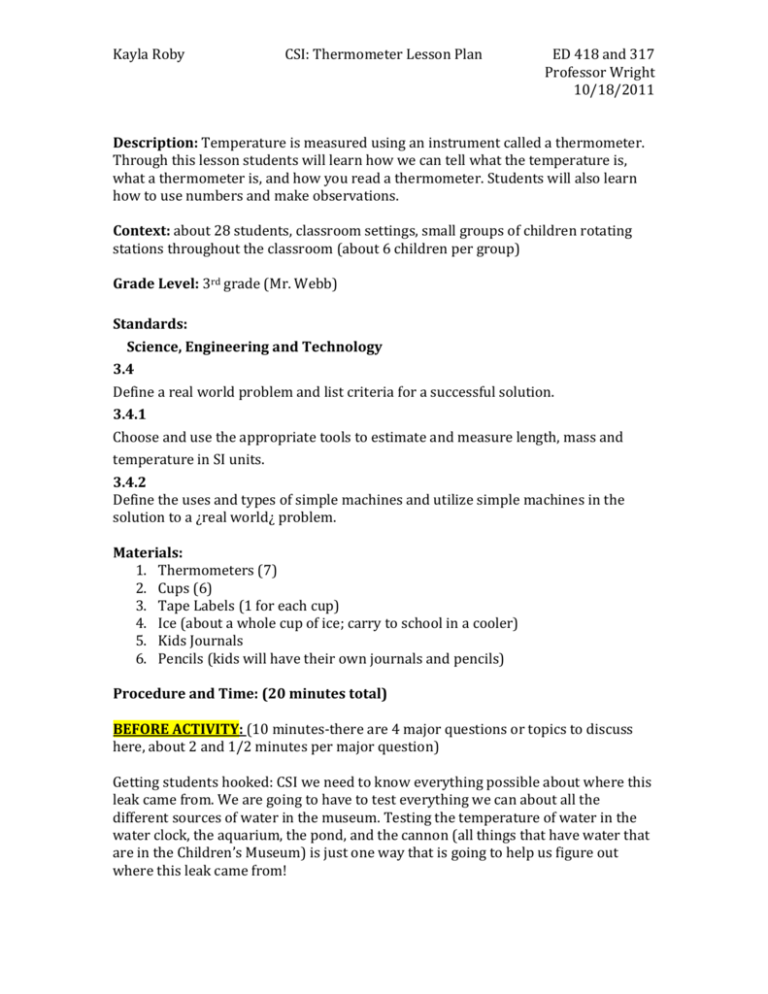
Kayla Roby CSI: Thermometer Lesson Plan ED 418 and 317 Professor Wright 10/18/2011 Description: Temperature is measured using an instrument called a thermometer. Through this lesson students will learn how we can tell what the temperature is, what a thermometer is, and how you read a thermometer. Students will also learn how to use numbers and make observations. Context: about 28 students, classroom settings, small groups of children rotating stations throughout the classroom (about 6 children per group) Grade Level: 3rd grade (Mr. Webb) Standards: Science, Engineering and Technology 3.4 Define a real world problem and list criteria for a successful solution. 3.4.1 Choose and use the appropriate tools to estimate and measure length, mass and temperature in SI units. 3.4.2 Define the uses and types of simple machines and utilize simple machines in the solution to a ¿real world¿ problem. Materials: 1. Thermometers (7) 2. Cups (6) 3. Tape Labels (1 for each cup) 4. Ice (about a whole cup of ice; carry to school in a cooler) 5. Kids Journals 6. Pencils (kids will have their own journals and pencils) Procedure and Time: (20 minutes total) BEFORE ACTIVITY: (10 minutes-there are 4 major questions or topics to discuss here, about 2 and 1/2 minutes per major question) Getting students hooked: CSI we need to know everything possible about where this leak came from. We are going to have to test everything we can about all the different sources of water in the museum. Testing the temperature of water in the water clock, the aquarium, the pond, and the cannon (all things that have water that are in the Children’s Museum) is just one way that is going to help us figure out where this leak came from! Kayla Roby CSI: Thermometer Lesson Plan ED 418 and 317 Professor Wright 10/18/2011 Share with students: Temperature is measured using an instrument called a thermometer. Does anyone know what temperature is? Students answers the degree of hotness or coldness of a body or environment. Does anyone know what a thermometer is? An instrument used to determine the temperature. Thermometers are commonly made from a glass bulb connected to a tube of glass with a numbered scale written on the outside. Inside the glass tube is a liquid like mercury or colored alcohol that rises and falls in the tube as the temperature around it warms or cools. When the temperature rises, the liquid in the glass tube warms up and molecules expand, which in turn takes up more space in the tube. Most thermometers have two temperature scales: Fahrenheit and Celsius. Both scales are divided in two-degree increments. When you read the temperature on a thermometer, it should be vertical and your eyes should be level with the top of the liquid in the glass tube. Avoid handling the thermometer when you take your readings. The heat from your hands will transfer to the glass causing its temperature to rise. 1. How can we tell what the temperature is? Have kids share ideas. Answers could be: we can feel the temperature or see our bodies react to temperature, as when we sweat or shiver. Or we can see evidence of the temperature by observing: a pond or pool of water freezing and thawing, wilting plant leaves on really hot days, seeing heat rise in a shimmer from pavement. Lead discussion to the point of realizing that we cannot tell the temperature accurately just by feeling it or observing our surroundings. We depend upon an instrument called a thermometer for accurate readings. 2. What is a thermometer? Have students look at their thermometers. Help them define what this instrument is made of: a glass bulb connected to a long and thin glass tube; glass tube has numbers written on it; inside bulb and in tube is a liquid (either mercury or a colored alcohol). 3. How do you read a thermometer? Lead discussion and ideas to the following points: Your eyes should be level with the top of the liquid in the tube to read it accurately. (You can have them test this—seeing that the reading is not the same when you look down or up onto the degree lines on the tube.) Handling the thermometer can affect its reading, as heat transfers from your Kayla Roby CSI: Thermometer Lesson Plan ED 418 and 317 Professor Wright 10/18/2011 hands (if warmer) or to the (if cooler) ACTIVITY: (10 minutes-should be about 1 minute for each measurement and recording 5 minutes total, leaving 5 minutes to review safety precautions, make sure students are recording correctly, and assess that they understand what a thermometer is and how to read it correctly) 4. Give each student or pair of students a thermometer. 5. Review safety precautions and fact that if thermometers are dropped or banged on a table they will break. (taking turns) a. Handle thermometers with care, there can be danger of broken glass. b. Students need to take turns measuring the cups of water. We do not want to spill any water. 6. Have students read their thermometers in the room. Record their findings in the journal. 7. Have students take the temperature of room temperature water. Record findings in journal. 8. Have students take the temperature of hot water. Record findings in journal. 9. Have students take the temperature of ice water. Record findings in journal. 10. Have students hold thermometer in their hands for a few minutes. Read thermometer and write down their findings. AFTER ACTIVITY: (done during activity-answer questions if we have time at the end) do assessment and make sure kids have written (recorded) correctly in their journals. Remind them why we learned how to use thermometers (CSI at children’s museum) Adaptations: Students who have difficulty reading and understanding thermometers: one on one help demonstrating and guiding the reading of thermometers. Students who have difficulty with discussion: there will be a space in their journal for reflections that they can write ideas if they do not feel comfortable sharing aloud Students who may have difficulty recording: guide them the correct way to do so and allow them to do the minimum recording required (description and measurement) Kayla Roby CSI: Thermometer Lesson Plan ED 418 and 317 Professor Wright 10/18/2011 Assessment: During discussion, note if students understand basic concepts of temperature and thermometer. The parts of a thermometer and how it works, and how to read a thermometer accurately. Students can also show others how to use and read a thermometer to share and to demonstrate what they know. Notes for me: Have students tell you these answers at the end of the lesson: 1. How can we tell what the temperature is? 2. What is a thermometer? 3. How do you read a thermometer?



